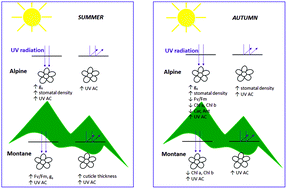Effect of UV radiation and altitude characteristics on the functional traits and leaf optical properties in Saxifraga hostii at the alpine and montane sites in the Slovenian Alps
Abstract
UV radiation affects the biochemical, physiological and morphological responses of plants. The effect is most pronounced at high altitude, such as alpine regions, and low latitude environments. The effect of UV radiation is impacted by different environmental conditions including temperature. We examined the response of the alpine plant Saxifraga hostii Tausch subsp. hostii growing at two altitudes (montane, 1100 m a.s.l. and alpine, 1500 m a.s.l.) in the Slovenian Alps. Selected ecophysiological, anatomical and pigment analyses along with measurements of the leaf optical properties were carried out during the growing season from July to September. Plants were grown under two different UV levels, near-ambient UV (UV) and reduced UV (UV-) radiation, and temperature conditions were monitored at both altitudes. Saxifraga hostii exhibited high photochemical efficiency of photosystem II and stomatal conductance under near-ambient UV radiation in August, which indicates that it is a well-acclimated plant. In September, photochemical efficiency was higher under reduced UV at the alpine altitude which together with a lower photosynthetic pigment content indicate delayed senescence for plants growing under reduced UV. Most leaf tissue thicknesses were not affected by UV radiation and altitude difference. There was a trend of increased stomatal density and reduced stomatal length on both leaf surfaces under near-ambient UV in August. However, there was no effect of UV attenuation or location at the alpine or montane site on the content of UV-B absorbing compounds, which implies the plant's tolerance of UV-B radiation. Saxifraga hostii leaves showed high absorption in the UV spectrum at higher altitudes, as shown by their optical properties. This study shows that Saxifraga hostii is well-acclimated to ambient UV radiation and to the environmental conditions at both altitudes. The effect of UV radiation is impacted by site conditions and this produces diverse plant responses, which contribute to the specific functional traits of Saxifraga hostii in the high-altitude environment.

- This article is part of the themed collection: Plant responses to UV


 Please wait while we load your content...
Please wait while we load your content...